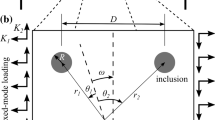Abstract
In polymer composites, inclusions (fillers) are introduced into the glassy polymeric matrices in order to improve the toughness properties as the brittleness is one of the fatal drawbacks for glassy polymers. For the first time, in our current study, the stress analysis has been performed on the interaction between a circular inclusion and a craze with an internal small crack in polymeric composites. A craze can be treated as a crack with fibrils bridging the two crack surfaces. The forces applied by the fibrils to the crack surfaces (pulling the two surfaces closer) depend on the crack opening displacement. However, the crack opening displacement is directly related to the forces applied by the craze fibrils. To solve this dilemma, an iterative procedure is proposed for the first time to solve the formulated singular integral equations. The craze thickness profiles, the cohesive stress distribution, and the fracture toughness of the polymeric composites are investigated thoroughly. Moreover, due to the influence of the inclusion, the uneven craze thickness profiles are observed from the left to the right part of the entire craze zone.
Similar content being viewed by others
References
Utracki, L.A., Jamieson, A.M.: Polymer Physics from Suspensions to Nanocomposites and Beyond. Wiley, Hoboken (2010)
Tonpheng, B., Yu, J., Andersson, B.M., Andersson, O.: Tensile strength and Young’s modulus of polyisoprene/single-wall carbon nanotube composites increased by high pressure cross-linking. Macromolecules 43, 7680–7688 (2010). doi:10.1021/ma101484e
He, R., Zhan, X., Zhang, Q., Zhang, G., Chen, F.: Control of inclusion size and toughness by reactivity of multiblock copolymer in epoxy composites. Polymer (UK) 92, 222–230 (2016). doi:10.1016/j.polymer.2016.04.003
Kitey, R., Tippur, H.V.: Role of particle size and filler-matrix adhesion on dynamic fracture of glass-filled epoxy. I. Macromeasurements. Acta Mater. 53, 1153–1165 (2005). doi:10.1016/j.actamat.2004.11.012
Kitey, R., Tippur, H.V.: Role of particle size and filler-matrix adhesion on dynamic fracture of glass-filled epoxy. II. Linkage between macro- and micro-measurements. Acta Mater. 53, 1167–1178 (2005). doi:10.1016/j.actamat.2004.11.011
Moloney, A.C., Kausch, H.H., Stieger, H.R.: The fracture of particulate-filled epoxide resins–part 1. J. Mater. Sci. 18, 208–216 (1983). doi:10.1007/BF00543827
Toepperwein, G.N., Karayiannis, N.C., Riggleman, R.A., Kröger, M., De Pablo, J.J.: Influence of nanorod inclusions on structure and primitive path network of polymer nanocomposites at equilibrium and under deformation. Macromolecules 44, 1034–1045 (2011). doi:10.1021/ma102741r
Richardson, D.G., Abrams, C.F.: The effects of nanotube fillers on craze formation in simulated glassy polymers under tensile load. Mol. Simul. 33, 421–427 (2007). doi:10.1080/08927020601154637
Kambour, R.P.: Structure and properties of crazes in polycarbonate and other glassy polymers. Polymer 5, 143–155 (1964)
Kambour, R.P.: Mechanism of fracture in glassy polymers. III. Direct observation of the craze ahead of the propagating crack in poly(methyl methacrylate) and polystyrene. J. Polym. Sci. Part B Polym. Phys. 4, 349–358 (1966)
Kambour, R.P.: Mechanism of fracture in glassy polymers. II. Survey of crazing response during crack propagation in several polymers. J. Polym. Sci. Part B Polym. Phys. 4, 17–24 (1966)
Knight, A.C.: Stress crazing of transparent plastics. Computed stresses at a nonvoid craze mark. J. Polym. Sci. Part A. Polym. Chem. 3, 1845–1857 (1965)
Lauterwasser, B.D., Kramer, E.J.: Microscopic mechanisms and mechanics of craze growth and fracture. Philos. Mag. A Phys. Condens. Matter Struct. Defects Mech. Prop. 39, 469–495 (1979). doi:10.1080/01418617908239285
Wang, W.C.V., Kramer, E.J.: A distributed dislocation stress-analysis for crazes and plastic zones at crack tips. J. Mater. Sci. 17, 2013–2026 (1982). doi:10.1007/Bf00540419
Ungsuwarungsri, T., Knauss, W.G.: A nonlinear analysis of an equilibrium craze: part I–problem formulation and solution. J. Appl. Mech. Trans. ASME 55, 44–51 (1988)
Ungsuwarungsri, T., Knauss, W.G.: A nonlinear analysis of an equilibrium craze: part II–simulations of craze and crack growth. J. Appl. Mech. Trans. ASME 55, 52–58 (1988)
Brown, H.R.: A molecular interpretation of the toughness of glassy polymers. Macromolecules 24, 2752–2756 (1991)
Marissen, R.: Craze growth mechanics. Polymer 41, 1119–1129 (2000). doi:10.1016/S0032-3861(99)00234-7
Hoh, H.J., Xiao, Z.M., Luo, J.: On the plastic zone size and crack tip opening displacement of a Dugdale crack interacting with a circular inclusion. Acta Mech. 210, 305–314 (2010). doi:10.1007/s00707-009-0211-2
Xiao, Z.M., Chen, B.J.: Stress intensity factor for a Griffith crack interacting with a coated inclusion. Int. J. Fract. 108, 193–205 (2001). doi:10.1023/A:1011066521439
Xiao, Z.M., Chen, B.J.: Stress analysis for a Zener-Stroh crack interacting with a coated inclusion. Int. J. Solids Struct. 38, 5007–5018 (2001). doi:10.1016/S0020-7683(00)00335-8
Hills, D.A.: Solution of Crack Problems: The Distributed Dislocation Technique. Kluwer, Dordrecht (1996)
Kramer, E.J., Hart, E.W.: Theory of slow, steady state crack growth in polymer glasses. Polymer 25, 1667–1678 (1984). doi:10.1016/0032-3861(84)90164-2
Erdogan, F., Gupta, G.D.: Stresses near a flat inclusion in bonded dissimilar materials. Int. J. Solids Struct. 8, 533–547 (1972). doi:10.1016/0020-7683(72)90021-2
Weertman, J.: Dislocation based Fracture Mechanics. World Scientific, Singapore (1996)
Tada, H., Paris, P.C., Irwin, G.R.: The Stress Analysis of Cracks Handbook. Del Research Corporation, Hellertown (1973)
Author information
Authors and Affiliations
Corresponding author
Rights and permissions
About this article
Cite this article
Zhang, Y.M., Zhang, W.G., Fan, M. et al. Stress investigation on a cracked craze interacting with a nearby circular inclusion in polymer composites. Acta Mech 228, 1213–1228 (2017). https://doi.org/10.1007/s00707-016-1773-4
Received:
Revised:
Published:
Issue Date:
DOI: https://doi.org/10.1007/s00707-016-1773-4




